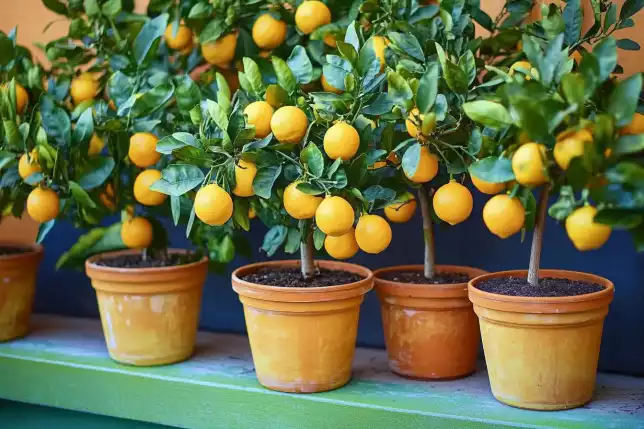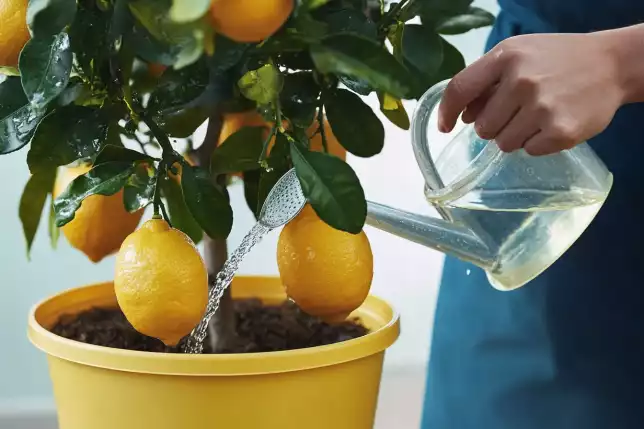Growing citrus trees in containers allows you to enjoy fresh lemons, limes, and oranges even if you have limited space. Container gardening is perfect for patios, balconies, or small yards. Follow this step-by-step guide to successfully grow healthy citrus trees that yield delicious fruit.

1. Choosing the Right Citrus Tree Variety for Containers
Selecting the right variety is crucial when growing citrus in containers. Dwarf and compact varieties are best for smaller spaces and containers.
Best Citrus Trees for Containers:
- Meyer Lemons: A popular variety with sweet, thin-skinned lemons.
- Key Limes: Ideal for small pots and abundant fruit production.
- Kumquats: A compact citrus tree perfect for containers.
Learn more about choosing fruit varieties for small spaces here.
2. Selecting the Right Container for Citrus Trees
Your container should provide enough room for root growth and ensure proper drainage. The size and material of the pot play a significant role in the health of your citrus tree.
Ideal Container Features:
- Size: Start with at least a 10-15 gallon pot to give roots room to grow.
- Material: Choose containers made from terracotta, plastic, or wood with good drainage holes.
- Stability: Ensure the container is stable enough to support the tree as it grows.
3. Best Soil Mix for Citrus Trees in Containers
Citrus trees require a well-draining potting mix. Using the right soil ensures that water doesn’t pool around the roots, which can lead to root rot.
Recommended Soil Mix:
- Soilless Mix: Use a soilless mix made for container gardening, which allows better drainage.
- Additives: Consider adding perlite or sand to improve drainage further.
4. Planting Your Citrus Tree
Once you’ve selected your tree and container, it’s time to plant. Follow these steps to ensure your citrus tree is planted correctly and thrives in its new home.
How to Plant:
- Step-by-Step Guide: Fill the container with soil, create a hole for the root ball, and position the tree so that the root crown is level with the soil surface.
- Repotting Tips: Citrus trees will need repotting every 2-3 years to ensure they don’t become root-bound.
External Resource: For additional tips, visit HGTV’s guide on growing citrus in containers.
5. Watering and Fertilizing Your Citrus Tree
Proper watering and fertilizing are essential to maintaining healthy citrus trees. Container-grown trees can dry out faster than those planted in the ground, so consistent care is crucial.

Watering Tips:
- Avoid Overwatering: Water deeply, but let the soil dry out slightly between waterings.
- Check Drainage: Ensure excess water drains away to prevent root rot.
Fertilizing Guide:
- Citrus-Specific Fertilizer: Use a fertilizer designed for citrus trees, applied in early spring and mid-summer for the best results.
6. Pruning and Training for Maximum Growth
Pruning helps shape the tree, control its size, and encourage fruit production. Training your citrus tree is especially important for container growing to maximize space and yield.
Pruning Techniques:
- Shape Control: Prune in late winter or early spring to maintain size and promote airflow.
- Training: For small spaces, espalier your citrus tree or use other vertical growing techniques.
7. Managing Pests and Diseases in Citrus Trees
Citrus trees grown in containers can be vulnerable to pests and diseases. However, with the right care, you can manage these problems effectively.
Common Pests:
- Aphids: Treat with insecticidal soap or neem oil.
- Spider Mites: Keep the tree well-watered and mist the leaves to discourage mites.
Common Diseases:
- Root Rot: Avoid overwatering and ensure good drainage.
- Citrus Canker: Remove infected branches and use copper-based fungicides if necessary.
8. Caring for Your Citrus Tree Throughout the Year
Caring for your tree year-round ensures healthy growth and consistent fruit production. From winter protection to moving the tree indoors, here’s how to care for your citrus tree throughout the seasons.
Seasonal Care Tips:
- Winter Protection: Move your citrus tree indoors when temperatures drop below 50°F.
- Indoor Care: Ensure the tree gets plenty of sunlight and avoid placing it near drafts.
9. Harvesting and Storing Citrus Fruits
Knowing when to harvest your citrus fruits ensures you enjoy them at their peak flavor. Proper storage also allows you to extend the life of your harvest.
Harvesting:
- Ripeness Indicators: Look for vibrant color and slight softness in the fruit when gently squeezed.
- How to Harvest: Use pruning shears to cut the fruit from the tree, avoiding damage to branches.
Storing Citrus Fruits:
- Short-Term Storage: Keep freshly harvested fruits in a cool, dry place for up to two weeks.
- Long-Term Storage: Refrigerate or freeze citrus for extended freshness.
Frequently Asked Questions
Q: How much sunlight do citrus trees need in containers?
A: Citrus trees need at least 6-8 hours of direct sunlight each day. If indoors, place your tree near a sunny window.
Q: Can citrus trees thrive in any container?
A: While citrus trees can grow in many container types, pots should be large enough for root growth and have excellent drainage.
Q: How often should I repot my citrus tree?
A: Repot your tree every 2-3 years to ensure it doesn’t become root-bound and to refresh the soil mix.
Conclusion
Growing citrus trees in containers is a rewarding and enjoyable way to produce your own fresh fruit, even if space is limited. By following these steps, from choosing the right variety to caring for your tree year-round, you’ll soon enjoy a thriving citrus tree full of delicious fruit.


2 thoughts on “Growing Citrus Trees in Containers: A Step-by-Step Guide”